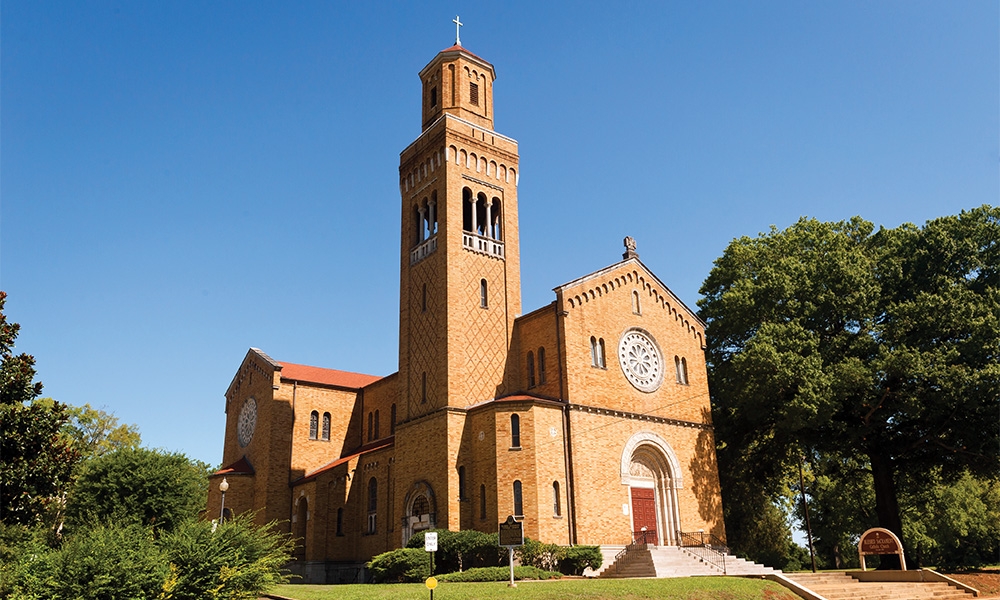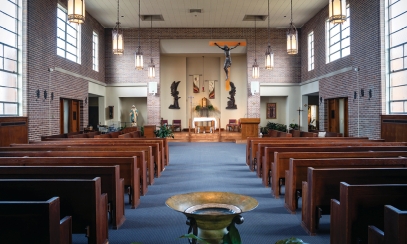
Blessed Sacrament
Blessed Sacrament Catholic Church located in the West End neighborhood of Birmingham is arguably one of the most beautiful churches in the Diocese of Birmingham. The parish’s roots can be traced back to the beginning of 1910 when 11 ladies met to discuss an idea. Since all local Catholic families traveled to St. Paul’s in downtown Birmingham, the ladies, later to be known as the “Catholic Ladies Club,” saw a need for the growing Catholic population in the area.
Blessed Sacrament Catholic Church located in the West End neighborhood of Birmingham is arguably one of the most beautiful churches in the Diocese of Birmingham. The parish’s roots can be traced back to the beginning of 1910 when 11 ladies met to discuss an idea. Since all local Catholic families traveled to St. Paul’s in downtown Birmingham, the ladies, later to be known as the “Catholic Ladies Club,” saw a need for the growing Catholic population in the area.
A little over a year later, Bishop Edward P. Allen, then bishop of the Diocese of Mobile, honored the ladies request, giving the green light to erect a Catholic church in West End. Father Patrick Turner was named as the first pastor.
It didn’t take long for the enthusiastic parishioners to get their new church built. In October of 1911, the “little white frame church” was finished, complete with a candelabra and a coal-burning stove. The next year saw Father Turner focusing on the opening of a school. He reached out to the Sisters of Perpetual Adoration, requesting that they open and run the new school. The sisters didn’t hesitate, and in October of 1912, the cornerstone was laid by Bishop Allen. Just over a year later, classes began in the school which offered a boarding academy, an elementary school and a high school.
In 1918, Father Turner resigned to serve as a chaplain in World War I. His successor was Father Lawrence J. Carroll, who served the parish for nine years. In 1927, Msgr. Walter J. Tobin was appointed as the pastor. One of his first actions as pastor was to address the need for a larger church building. Father Tobin sought out the ladies club, who had long been working towards a newer and bigger church.
After a meeting with the architect, the decision was made to have the exterior hearken back to the Renaissance period with the interior featuring a Romanesque style. Building began in 1928, not long before the Stock Market Crash of 1929, which, unfortunately, did not spare the parish. The interior was inornate, the widows were merely frosted, and the marble altars were donated by Mobile’s Cathedral of the Immaculate Conception.
Despite the hardships faced during the Depression, Bishop Thomas J. Toolen, then bishop of the Mobile Diocese, dedicated the new church on Feb. 23, 1930. Financial woes, however, were not the only concern. The 1930s were a time of bitter anti-Catholic sentiments. Men and boys of the parish had to patrol the grounds of the church and school at night for fear the buildings would be burned or vandalized.
Thankfully, the parish survived the ’30s and the war years. In the 1950s, Msgr. Tobin struggled with illness, leading to Msgr. George William Keyes’ arrival as pastor in 1954.
Under Msgr. Keyes, the original construction loans were paid off, clearing the way for the decoration of the barren, Depression-era interior of the church. In 1955, the red marble altar, the baldachin, and the ceiling and wall decorations were added.
In 1967, Msgr. Edwin J. Bobe became the fifth pastor, followed by Fathers Michael J. White and Peter T. McCarthy. Father McCarthy had to suffer the loss of the Sisters of Perpetual Adoration in 1975, who withdrew from the school due to a shortage of vocations to their community. Five years later, the parish marked two milestones: one positive, one negative. In February of 1980, the parish marked the 50th anniversary of the current church building’s dedication. Only four months later, though, the parish’s school, which had served the community for over 67 years, was closed due to low enrollment.
After Father McCarthy’s tenure, Fathers Donald Grainger, L.J. Bauler, and Matthew F. Brennan followed as pastors. In the 1980s and 1990s, under Father Brennan, the parish experienced a renewed spirit, for many of the beloved parish traditions were reestablished. It was also during this time that renovation of the exterior and interior of the church took place.
Following Father Brennan’s departure, Fathers Gregory T. Bittner and Jose Manjaly served as pastors. Father Manjaly led the congregation through hard economic times from 2007 to 2010 and assisted with the campaign to get the parish listed on the Jefferson County Historical Register, which paved the way for the church’s listing on the National Register of Historic Places in 2015. Father Manjaly was also instrumental in welcoming the Latin Mass to Blessed Sacrament.
In 2010, Father Jim Booth arrived just in time to help mark the parish’s 100th anniversary. Of that milestone, Father Booth wrote, “Blessed Sacrament, her people, and her clergy have been integral parts of the lives of many thousands of people over the last century. Yet our celebration is not simply rooted in the past. This centennial year marks the beginning of a new century of serving the faithful in West End and throughout the metropolitan Birmingham community.”
Staying true to those words, in May of 2018, Father Booth welcomed three Franciscan friars of the Poor of Jesus Christ, whose primary mission is outreach to the homeless. Somewhat later, the friars moved to Our Lady of Fatima Catholic Church, making way for the Poor of Jesus Christ to send four sisters to live at Blessed Sacrament. In conjunction with the friars, the sisters served the homeless of Birmingham until August of 2023 when the sisters reluctantly left due to hardships arising from federal immigration policies regarding religious worker visas.
As Blessed Sacrament writes its next chapter, the parish, with Father Booth as their guide, will continue to be a community of faith committed to our “eternal and unchanging Great High Priest, Jesus Christ.”



